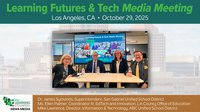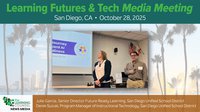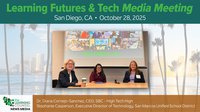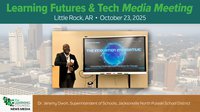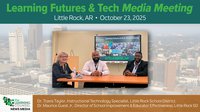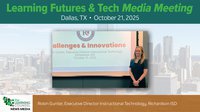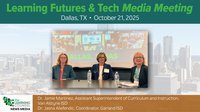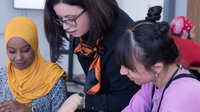Every individual grasps educational concepts differently, powered by their own curiosity, prior knowledge, and learning preferences. Consider your own learning and work preferences - when assembling a piece of furniture, do you complete the job faster when following written or visual instructions? Is a quiet office conducive to concentration, or do you need the ambient noise of a busy coffee shop to find your flow?
If we know first-hand that personalized learning is effective, why are school systems limiting our students' educational experiences? Instead of providing teachers the autonomy and resources to tailor lessons to each student, districts often utilize a one-size-fits-all curriculum model. We associate success with quantitative measurements, basing credits on how many hours students spend in the classroom and success on how accurately they can complete assignments in the time given.
Thankfully, many schools are recognizing the disconnect and beginning a paradigm shift from the Carnegie Unit of “credit hours” toward a mastery-based approach to learning. Central to the movement is John Carroll’s Learning Model, an academic framework built on four pillars that proposes aptitude has more to do with learning rate than learning potential. Carroll calls us to believe that students can learn anything if the right conditions are created.
As district leaders, educators, and parents, it’s important to break down and understand Carroll’s four pillars to determine how to best implement his practices in the classroom and expand these principles to home. By creating educational environments that honor Carroll’s stance that the time a child needs to learn is proportional to their ability to comprehend instruction, we can build on the incredible foundation our teachers have set and ensure every child maximizes their learning potential.
1. Student’s Ability to Understanding Learning Goals
Imagine going on a trip without a clear destination or a map to guide you. Frustrating, right? When students don’t understand every learning goal they need to hit, they experience a journey of confusion day after day.
The first pillar in Carroll’s model emphasizes clarity and preparation. It’s about ensuring students know what they’re aiming for, why it matters, and whether they have the prerequisite skills to access the new learning targets.
In the fast-paced world of education, districts find it easier if their teachers stick to rigid curriculum guides. But what if we allowed students to progress at their own pace once their goals are defined? Aligning instructional pacing with students’ readiness for learning isn’t about lowering standards but ensuring foundational skills are rock-solid before moving on. When students understand and achieve their goals, they experience a sense of accomplishment that fuels their desire to tackle new concepts.
In Carroll’s classroom, every assignment is “respectfully challenging”—tough but doable tasks designed to push students beyond their comfort zones. This approach transforms learning from a chore into a series of achievable, motivating steps.
2. Quality Instruction
Quality of instruction is the cornerstone of an engaging learning experience. It's not just about delivering content; it's about crafting an environment where students are curious, motivated, and inspired. High-quality instruction is characterized by the ability to connect lessons to real-world applications, making learning both tangible and impactful.
Think about it: students are more likely to engage when they see the relevance of what they're learning first-hand. Effective teachers don't just teach; they demonstrate how academic concepts apply outside the classroom. In Elizabethton, Tenn., for instance, a high school sociology class solved a decades-old murder case because students pushed for more engaging classes, and their teacher obliged with project-based learning, real-world problem-solving tasks, and community partnerships.
Great teachers empower students to take ownership of their learning. When students set goals, reflect on their progress, and choose their learning paths, they become more deeply invested in their education. This autonomy boosts engagement and fosters a lifelong love of learning. Quality instruction is about moving beyond passive learning to create active, meaningful educational experiences.
3. Fostering Perseverance
Perseverance is the secret sauce of success. But how do we foster it? Angela Duckworth’s research on grit tells us that people give up when tasks feel boring, pointless, or impossible. So, Carroll’s third pillar focuses on making learning meaningful and achievable.
Building strong relationships between students and adults is crucial. When students feel understood and supported, they're more likely to persevere. Regular interactions with teachers build trust and rapport, ensuring students feel comfortable and safe asking for support. In addition, mastery-based learning helps students grasp that failure is a step on the road to progress. They have multiple opportunities to learn and persist until they understand a difficult concept.
Parents and educators must also teach students the non-academic skills that translate into success, including resilience and effort. When students know their hard work makes a difference, they’re more likely to push through challenges.
4. Providing Adequate Time
Schools that treat time as a variable rather than a constant will see improved student engagement and outcomes. Traditional school systems often impose one-size-fits-all timelines, but learning doesn’t work that way. Carroll’s final pillar advocates for flexible timelines that accommodate individual learning rates.
Consider a grading system that reflects true mastery rather than a rush to meet arbitrary deadlines. In this system, grades would reflect what students actually understand, not just what they can recall under pressure. Students would progress based on readiness, not a rigid schedule.
Flexible daily schedules further support diverse learning paces. Students can spend more one-on-one time with teachers to receive the help necessary to succeed. In addition, accessing digital tools, videos, and other supplemental learning resources where and when they learn best allows students to break down lessons into manageable chunks, practice learning activities, and retake assessments until they master a concept.
Allowing flexibility isn’t about coddling; it’s about recognizing that learning is personal and should be tailored to each student’s needs.
Using Carroll’s Pillars to Build a Stronger Classroom
Inspiring a lifelong love of learning is at the heart of almost every school district’s mission statement, but what are we actually doing to achieve it? John Carroll’s Learning Model offers a transformative approach to education that prioritizes understanding learning goals, ensuring quality instruction, fostering perseverance, and allowing adequate time for mastery. By embracing these pillars, we can create educational environments where every student has the opportunity to succeed.
In Carroll’s model, aptitude isn’t a fixed potential but a learning rate—a concept that places time as a flexible, responsive education component. This shift in mindset calls us to believe that all students can learn if the right conditions are created. By adopting this approach, we pave the way for an educational system that genuinely supports every learner’s journey. Let’s move toward a future where education is not just about passing tests but empowering every student to reach their full potential.
About the author
George Philhower, Ph.D. is superintendent of CSC of Eastern Hancock County.




